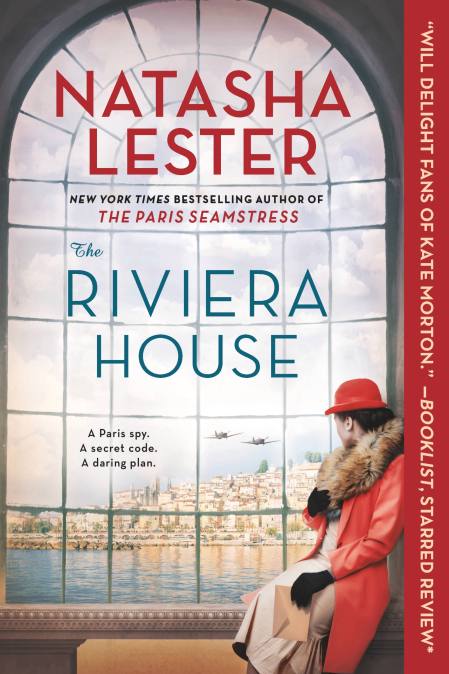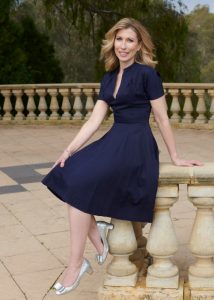
THE RIVIERA HOUSE
A lush and engrossing novel of one woman’s quest to keep Nazis from stealing priceless art during WWII, perfect for fans of The Rose Code.
Paris, 1939: The Nazis think Éliane can’t understand German. They’re wrong. They think she’s merely cataloging art in the Louvre and unaware they’re stealing national treasures for their private collections. They have no idea she’s carefully decoding their notes and smuggling information to the Resistance. But Éliane is playing a dangerous game. Does she dare trust the man she once loved with her secrets, or will he only betray her once again?
A lush and engrossing novel of one woman’s quest to keep Nazis from stealing priceless art during WWII, perfect for fans of The Rose Code.
Paris, 1939: The Nazis think Éliane can’t understand German. They’re wrong. They think she’s merely cataloging art in the Louvre and unaware they’re stealing national treasures for their private collections. They have no idea she’s carefully decoding their notes and smuggling information to the Resistance. But Éliane is playing a dangerous game. Does she dare trust the man she once loved with her secrets, or will he only betray her once again? She has no way to know for certain . . . until a trip to a stunning home on the French Riviera brings a whole new level of peril.
Present Day: Wanting to forget the tragedy that has left her life in shambles, Remy Lang heads to a home she’s mysteriously inherited on the Riviera. While working on her vintage fashion business, she discovers a catalog of the artworks stolen during World War II and is shocked to see a painting that hung on her childhood bedroom wall. Who is her family, really? And does the Riviera house hold more secrets than Remy is ready to face?
- Grand Central
- Paperback
- August 2021
- 480 Pages
- 9781538717318
About Natasha Lester
 Natasha Lester worked as a marketing executive for L’Oreal before penning the New York Times and internationally bestselling novel The Paris Orphan. She is also the author of the USA Today bestseller The Paris Seamstress. When she’s not writing, she loves collecting vintage fashion, traveling, reading, practicing yoga and playing with her three children. Natasha lives in Perth, Western Australia.
Natasha Lester worked as a marketing executive for L’Oreal before penning the New York Times and internationally bestselling novel The Paris Orphan. She is also the author of the USA Today bestseller The Paris Seamstress. When she’s not writing, she loves collecting vintage fashion, traveling, reading, practicing yoga and playing with her three children. Natasha lives in Perth, Western Australia.
Praise
“In Hitler’s war on civilization, a group of women and men risk everything to protect the art in their care, but it’s not until decades later that the profound extent of their sacrifice is discovered. The Riviera House is a love letter to art in all its forms. With beautiful prose and immeasurable heart, Natasha Lester shows we must dare to love, in spite of fear, no matter the cost.”—Erika Robuck, national bestselling author of The Invisible Woman
“Suspense, intrigue and self-sacrifice are at the heart of this fascinating story about artwork stolen by the Nazis, based on real people and true events.”—Ruth Druart, Sunday Times bestselling author of While Paris Slept
“Delectable and daring, The Riviera House takes readers from wartime Paris to the sun-soaked French Riviera and beyond, populating its world with fabulous fashion, unforgettable characters, vibrant masterpieces — and intrigue at every turn.” —Bryn Turnbull, author of Woman Before Wallis
“Lester is a master storyteller. “—The Daily Telegraph on The Paris Secret
“Gripping from the first page, a compelling story of mystery and intrigue, and I couldn’t put it down.”—Tania Blanchard, author of Letters from Berlin
Discussion Questions
- Before reading the book, did you know about the theft of artworks from Jewish families in Paris by the Nazis during WWII? Had you heard of Rose Valland and her role as art saviour? Why do you think the story of these paintings, and that of their protector Rose Val- land, is a less well-known aspect of wartime history? Did reading The Riviera House make you want to find out more about Rose?
- Éliane asks her brother if, after the war, they will be judged by others and whether“instead of saving paint- ings, we should be saving people.” What do you think? Were the paintings worth the danger of spying on the Germans? Should her efforts and Rose’s efforts have been focused on rescuing people rather than rescuing artworks? What is the value of a piece of art?
- In the Author’s Note at the end of the book, Natasha Lester explains that Rose Valland came by Göring’s Catalogue sometime after 1944, kept it a secret, and that the catalogue was only discovered after her death. Why do you think Rose didn’t share the catalogue more widely? Should she have? What might have im- pelled her to keep it a secret?
- Like Natasha Lester’s other books, The Riviera House mixes real people and real events with fictitious peo- ple and fictional events. What do you think of this approach to writing historical fiction? Is it wrong to create a narrative around Rose Valland and then change some of the events and insert people into those events who didn’t exist? Or can this way of tell- ing a story bring the events of the past to life and en- sure these events and people reach a wider audience so that more people can learn from and about history?
- One of the themes of the book is about what makes a culture – is it the people, the language, the artworks, the buildings, the collective spirit – and whether war can destroy a culture or make it stronger. “So many things worth preserving have been ruined,” Xavier says to Éliane at one point. Why does war ruin some people and bring out the best in others? What parts of your culture are worth preserving and would you fight to protect them?
- In the contemporary narrative, did you enjoy visiting the towns of Saint-Jean-Cap-Ferrat and Èze? Which elements of this narrative were your favorite? Be- ing introduced to the photography of Lousie Dahl- Wolfe? Remy and Adam’s love story? Remy’s journey through grief and to a new way of understanding both herself and her past? Something else?
- Remy’s home on the French Riviera is based on the Villa Ephrussi de Rothschild in Saint-Jean-Cap-Fer- rat. Google some pictures of the house and discuss how the two houses are similar and different. Did reading about the house bring it to life in the same way as the pictures do? Does it look how you imag- ined it might?
- Matt and Adam have a complicated relationship. Is Adam always understanding of his brother’s pain or does Adam inflame the situation? Or is Matt solely to blame for their conflict? When could both of the brothers have behaved differently toward each other and thus improved their relationship?
- Should Elke have done more to help Éliane and to actively work against her husband – or was Elke in an impossible situation? Most especially, do you think Elke could have done something toward the end of the book to ensure the baby stayed with Éliane? Or would that have placed the baby in too much danger?
